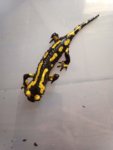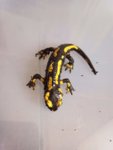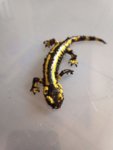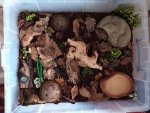I got four fire salamanders back in early March. Their enclosure is bio-active with a coco fibre + cypress mulch bedding covered in leaf litter and on top of a drainage layer. There is a water bowl in one corner that's about half full to prevent drowning and several hides around the enclosure. The temperature is around 15-17 degrees Celcius and the humidity is usually 99/100% but has dropped to 60% in the past; the bedding is damp and not soaked.
Three of the salamanders have eaten for me only once and the fourth hasn't at all and is looking thin compared to the others.
Tong feeding is unsuccessful, I think they are scared of the tongs, so I place the worms in front of where the salamanders are hidden in hopes they will see them and eat.
I have read dozens of posts on this topic in this forum as well as others and tried the suggestions mentioned but haven't had much success.
I have tried feeding them a variety of foods (about a week between feedings) such as crickets, mealworms, waxworms, formulated paste and earthworms. I have had the most (only) success with earthworms.
A lot the time, the salamanders look interested in the worm but either don't do anything or move too slow, allowing the worm to dig into the soil.
Other times, the salamanders bite at the worm but miss (some don't even "lunge" - just open/close mouth). When this happens they give up after the first attempt and walk off.
I will try dangling a cut piece of a worm in front of their hides that is the size of their head. Currently the worms have been just shorter than the salamander in length.
Any help and advice will be greatly appreciated. The first image is of the salamander which hasn't eaten.



Three of the salamanders have eaten for me only once and the fourth hasn't at all and is looking thin compared to the others.
Tong feeding is unsuccessful, I think they are scared of the tongs, so I place the worms in front of where the salamanders are hidden in hopes they will see them and eat.
I have read dozens of posts on this topic in this forum as well as others and tried the suggestions mentioned but haven't had much success.
I have tried feeding them a variety of foods (about a week between feedings) such as crickets, mealworms, waxworms, formulated paste and earthworms. I have had the most (only) success with earthworms.
A lot the time, the salamanders look interested in the worm but either don't do anything or move too slow, allowing the worm to dig into the soil.
Other times, the salamanders bite at the worm but miss (some don't even "lunge" - just open/close mouth). When this happens they give up after the first attempt and walk off.
I will try dangling a cut piece of a worm in front of their hides that is the size of their head. Currently the worms have been just shorter than the salamander in length.
Any help and advice will be greatly appreciated. The first image is of the salamander which hasn't eaten.




